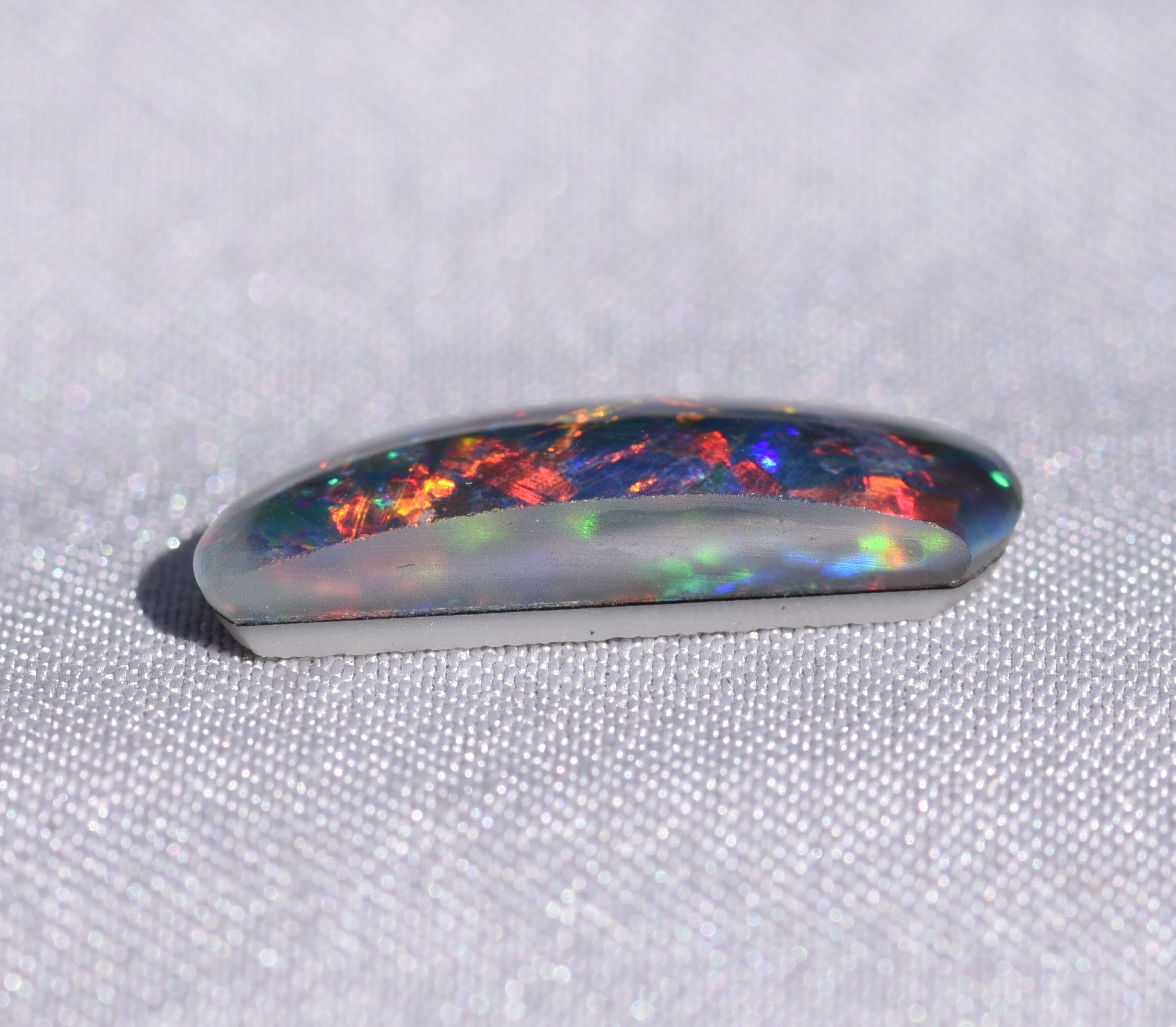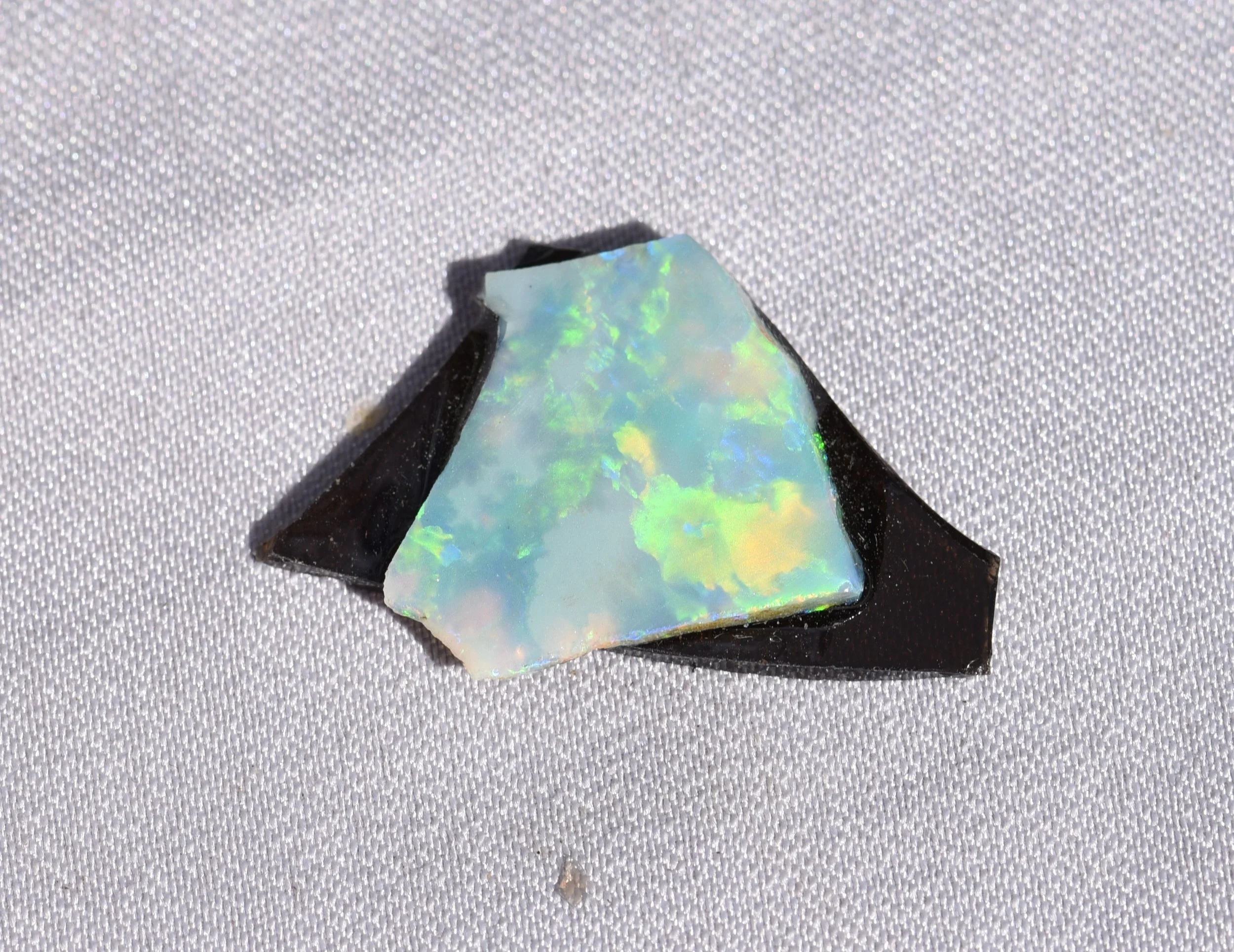The Story of Hydrophane Opal
WHAT IS HYDROPHANE OPAL?
Hydrophane for a long time has been a mineralogical name given to opal which is absorbent. Typically the mineralogical discussion revolved around this opal types ability or characteristic to absorb water (Hence the ‘hydro’). Secondly as the water was absorbed into the opal the result was that the appearance of the opal changed (this is the reason for ‘phane’).
As stated above, most of the time hydrophane was encountered it was only as a mineralogical specimen, and as such was only described in mineralogical literature.
SOME MINERALOGICAL TEXTS
DANA’S SYSTEM OF MINERALOGY (FRONDEL 1962) DESCRIBES HYDROPHANE AS:
“A white or light coloured translucent to opaque type of opal that becomes virtually transparent when placed in water.”
MINERALOGY - JOHN SINKANKIS (1964) DESCRIBES HYDROPHANE OPAL AS:
“Cachalong and Hydrophane are white, opaque, or barely translucent porous kinds (kinds of opal) which absorb considerable water; if the material becomes translucent after soaking (in water), it is called hydrophane, the latter may or may not also show play-of-colour.”
POROUS OR ABSORBANT?
There is a difference when discussing the nature of opal and opaline silica as to whether the material is porous or non porous, and in this discussion it may well be more important in the discussion to ask if the gemstone is porous or absorbent.
It comes down to different dictionary “definitions” or the English word porous, and how languages and meaning change may over time.
Porous or porosity
For example, the Webster’s new international dictionary (1950) entry states:-
Porous “full of pores; hence , capable of absorbing moisture, permeable by liquids.”
The Australian Macquarie dictionary 3rd edition (1997) states:-
Porous 1. full of pores, 2. permeable by water, air , or the like”
Both statements are ambiguous, when it comes to a discussion of opal.
Wikipedia perhaps comes closer to the issue and does not discuss “porous” but “porosity”
“Porosity is a measure of the void spaces in a material “ (summarised by the curator!).
This is more to the point, the precious opal structure of minute spheres presents a material that has small voids, which are often seen in electron micrographs as “holes”. (read more on the academy website under the science tab and opal structure).
An electron micrograph of Play-of-colour opal and sphere structure 80,000x
As an example the photo micrograph (left) show the “voids” or “holes” in between the spheres of precious opal in this regular array of spheres which produces the Play-of-Colour seen in precious opal. The ‘black’ irregular shapes are the voids in this precious sphere type Boulder opal from Queensland, Australia.
Note that this material is NOT absorbent, yet under the definitions above, may be considered as “porous”
A electron micrograph of an Hydrophane opal which does not show Play-of-colour 80,000x
The electron micrograph shown left is an example of Hydrophane opal that does not show evidence of Play-of-colour as the structure does not show a regular array of spheres. It is used here as an example which shows the more open structure of a hydrophane opal.
Curators Note: It would seem that for the present, a suitable micrograph of ‘Precious’ hydrophane opal is not yet available for comparison, if any of my colleagues have one please contact the curator!
Absorbance or absorbency
The Webster’s new international dictionary (1950) entry states:-
absorb: to swallow up, to engulf.
The Macquarie dictionary 3rd edition (1997) states:
Absorb, 3. to suck up or drink in (liquids) absorbent: capable of absorbing.
Why spend so much time here?
These definitions or meanings are important as some texts and discussion say may that “all opal is porous”. This statement is not necessarily so (see discussion on opal structure (yet to be posted). Much precious opal can be considered as being porous. As already mentioned there are voids in between the spheres in the structure of precious opal. However these opals may not be ‘absorbent’.
Here then is an important distinction, perhaps repeated….
The voids in the spheres of most precious opal and certainly the precious opal from Australia are not interconnected. So the material may well be considered as “porous’ however as the voids are not interconnected, so they are not absorbent or capable of absorbing water or fluids.
The voids in precious (and other ) hydrophane opals are interconnected in its structure and so are absorbent and these opals are capable of absorbing water and fluids.
THIS IS AN IMPORTANT DISTINCTION!
ABSORBENCY IS THE ISSUE, NOT POROSITY!
hydrophane opal and Ethiopia
AS mentioned above, until the turn of the century, most hydrophane opals appeared to only be of a mineralogical interest. It is difficult to find references in literature that talk very much about hydrophane opal.
What has substantially changed this situation in gemmology or the gemstone industry was the discovery of large amounts of Hydrophane opal, both precious hydrophane and common hydrophane.
The first occurrences that appeared were associated with a deposit in Yita Mikael, North Shoa province. However the most important opal discovery came later in 2008 near the town of Wegel Tena (in Wollo province). See the Literature section, however for now this information is recorded for the reader in a paper delivered in the Canadian Mineralogist. “Pedogenic origin of Mezezo opal hosted in Ethiopian Miocene Rhyolites” Ayalew et al, Canadian Mineralogist Volume 58, pp231-246, 2020.
Substantial quantities of this material have now become a part of the opal market in gemstone trading.
You can read more about these deposits in the
Ethiopia - occurrences section of the opal academy. (which is yet to be posted).
Perhaps before that time Hydrophane opal has been reported from the Virgin Valley deposits in the USA. Since that time hydrophane opal has been found in Indonesia, and even a non precious common opal variety in the Boulder opal fields of Queensland Australia
CURATORS NOTE:
If any of my opal colleagues reading this note regarding hydrophane opal and are aware of other occurrences, then we would like to here about the occurrence, and even request information regarding the way to obtain or purchase samples for further scientific research and reporting.
Hydrophane immersion in water.
A piece of “white” rough precious hydrophane opal which is almost opaque was prepared into a section about 3mm in thickness. The Hydrophane opal was then immersed in water in a container. Withdrawn at approximately 5 minute intervals and photographed. Note that the piece is a rough sawn piece of opal and not polished or prepared in any other way.
The photographs below are representative of Hydrophane opal. You can read more in several published reports, and they are listed below.
Hydrophane Opal before immersion in water. Note that the opal appears predominantly opaque. There is a hint of Play-of-Colour at the bottom of the photo.
Hydrophane Opal after immersion in water for approximately 10 minutes. Typically with immersion in water the initial onset of absorption of the water appears to be slow.
Hydrophane opal after immersion in water for approximately 15 minutes.
Hydrophane opal after immersion in water for approximately 20 minutes
Hydrophane opal after immersion in water for approximately 25 minutes
Hydrophane opal after immersion in water for approximately 30 minutes. The absorption of the water is now essentially complete, The slight misty appearance is due to the surface of the opal starting to dry.
video of the gemmological process of specific gravity (density) determination.
The normal procedure for a gemmologist to determine the specific gravity of a gemstone by the hydrostatic method is to first weight the item in air, and then to immerse the gemstone in water to determine the weight loss when weighed in water through Archimedes principal. Note that this is a very difficult thing to do with a piece of hydrophane opal due to the characteristic of the porosity of hydrophane opal. Hence as water is absorbed by the gemstone being weighed, the opal actually becomes “heavier” due to water absorption into the stone.
The video shows a small droplet of water being absorbed into the hydrophane opal and shows the last 1 minute 40 seconds of the absorption.
A comparison of water absorbancy between Lightning ridge black opal and hydrophane opal
An experiment made by viewing under the microscope, of the absorbency of a small (pinhead) blob of water applied to the surface of the two opals. Note that the video is only about a minute long. In this instance the video has been cropped to show the last minute of the experiment. A longer version (approximately 5 minutes is also available below).
A TEST OF ABSORBANCEY AND DRYING
An experiment was performed in which two samples of Hydrophane opal were immersed in the water of attached to a balance as illustrated above, and the absorption of water was recorded over time. One sample was small, approximately 1.63 grams (…carats), the other much larger 17.4 grams (….carats) and continually weighed until it appeared the absorption was complete. The experiment was not conducted under strict laboratory conditions, rather the gemmological testing facility (home office) of Advanced Gemmological Services Pty Ltd)
A record of the change of weight for a hydrophane opal specimen, small, as the sample absorbs water.
A record of the change of weight for a hydrophane opal specimen, larger, as the sample absorbs water.
DRYING OUT
After the above experiments of water absorption were done, two specimens we immersed in water and then removed from a water bath, these specimens were “tissued” dried to remove excess surface water and then monitored (and recorded) over time as they dried out, not to completion. The graphs are indicative only of the drying out under ambient conditions of a room at normal humidity and temperature in the office in Sydney. Opal Academy is working on a new publication under more “scientific” and controlled conditions…watch this space!
A record of the change in weight of a hydrophane opal specimen as the sample dries out under ambient room conditions of temperature and pressure.
A record of the change in weight of a hydrophane opal specimen as the sample dries out under ambient room conditions of temperature and pressure. The “kink” in this graph is likely due to temperature change in the room where the experiment was conducted!
some consequences
One of the consequences or “by products” of precious hydrophane opal being distinctly absorbent , and especially with a liquid like water is that the interconnected pores in hydrophane allow the incorporation of various other liquids and substances, this allows the material to be susceptible to various types of treatments.
Typically since the advent of this hydrophane material, attempts to “treat” the gems to be “Black” and imitate natural black opal have become profound. You can read about these treatments on the treatments and gemmology pages of the opal academy.
Other treatments allow the body colour of the opal to be treated to any colour that suits the persons doing the treatment.
Neither of these treatment processes is in itself a bad process, with one caveat however.
THE TREATMENT MUST BE DISCLOSED, AND IF THIS IS NOT DONE IT MAY BE CONSIDERED TO BE FRAUDULENT.




























